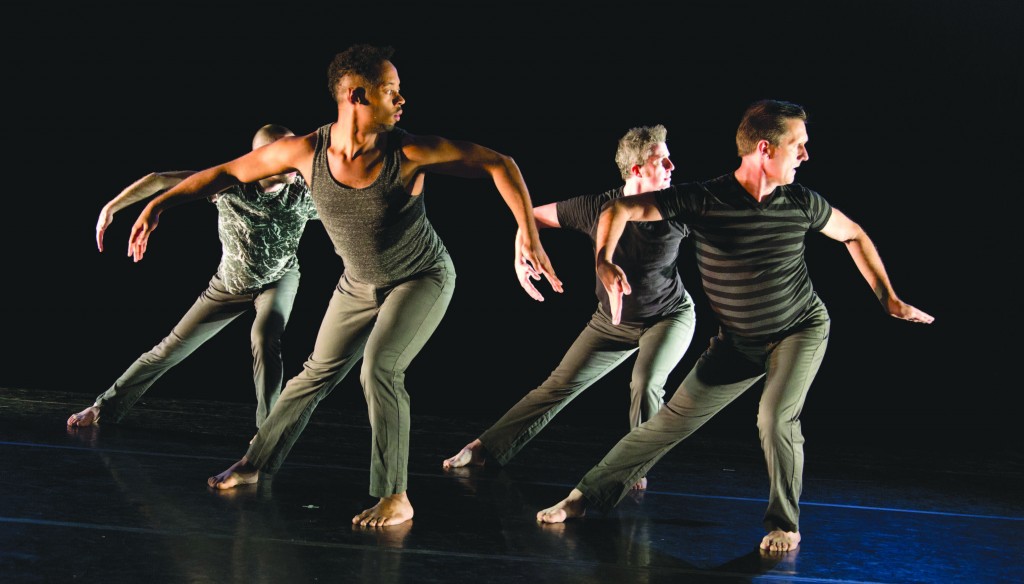Trailblazing transgender choreographer Sean Dorsey is known for creating powerful dances with transgender and LGBT themes. Dorsey has toured his work to 26 cities across the U.S., and was recently awarded an Isadora Duncan Dance Award for his newest work, The Missing Generation. It is based on oral history interviews Dorsey recorded with LGBT longtime survivors of the early AIDS epidemic. The work returns to San Francisco May 5–7 as part of a 2-year, 20-city tour.
San Francisco communities will also have the rare opportunity to see panels of the AIDS Quilt, on display in Z Space’s lobby. While creating the show, Dorsey interviewed 25 longtime survivors, including lifelong AIDS Quilt caretaker Gert McMullin (Atlanta) and early Quilt activist Evelyn Martinez (San Francisco). McMullin and Martinez worked closely with Dorsey to bring panels to display at the theater.
We sat down with Dorsey to ask him about the show, LGBT history, grief and inter-generational healing. As he says, “Our culture has totally turned its back on the early AIDS epidemic, as well as its survivors. There is a generation amongst us holding all this trauma and mass death and grief. The Missing Generation invites us to attend to and hold this generation.”
The Missing Generation is an invitation to witness and heal—through gorgeous high-intensity dance, eloquent gestures, intimate storytelling and luscious partnering. Free rapid HIV testing will be available at the theater on Thursday, May 5. A special Gala performance and reception with the artists is on Saturday, May 7.
San Francisco Bay Times: Please tell us more about how you created The Missing Generation.
Sean Dorsey: I spent two years creating the show. During the first year, I traveled the U.S. to record oral history interviews with longtime survivors of the early AIDS epidemic. After recording 75 hours of oral history interviews, I spent over 500 hours building a soundscore featuring voices and stories from these extraordinary interviews—along with gorgeous original music by my team of composers. Then I spent a year in the studio with my dancers, choreographing the work.
San Francisco Bay Times: The Missing Generation is clearly a labor of love for you all.
Sean Dorsey: Yes, I talk about the show being my “love letter” to a forgotten generation. I created the show after feeling a deep calling to do this work. And performing the show is an absolute marathon. We are dripping with sweat in the first 15 minutes; it’s a very, very physical show that demands we dance full out for 65 minutes with guts and precision and deep humanity. My beautiful dancers (Brian Fisher, ArVejon Jones, Nol Simonse) and I give so much of ourselves to the work and to our audiences.
San Francisco Bay Times: You are currently on a two-year, 20-city tour with the work. What has been one of the most surprising things about performing this work on tour?
Sean Dorsey: Two things: the first is how little young people are being taught about the early AIDS epidemic. This was one of the most important and pivotal periods of contemporary American history, and we are teaching younger generations almost nothing about it. The early AIDS epidemic was a huge crucible for LGBT activism—it’s when lesbians and gay men first came together socially and politically; it’s when trans and queer people created new models for street actions, art-as-activism, die-ins, and political advocacy. It’s when the idea and term “LGBT” was born. It’s when the movement for queer marriage began (largely because people were refused access to their dying lovers in hospitals).
The other surprising thing is how deeply passionate young people are about wanting to learn about this history. Our audiences range from 15 year olds to 88 year olds. It’s a very powerful part of touring with this work—bringing multiple generations of people together to witness, to feel, to grieve, to rage, to celebrate, to inspire, to heal.
San Francisco Bay Times: What do you think dance offers that other art forms or mediums cannot?
Sean Dorsey: Dance is the most visceral art form I know. It can move and inspire and transform society and us. But you know, most people feel like modern dance is totally irrelevant to their lives; that they don’t “get” it. I think this is true of much modern dance! My job as a choreographer is to make dances that resonate deeply with people–that people can understand, relate to, and be deeply moved by. That’s what The Missing Generation does. It names and holds our broken hearts–broken by the early AIDS epidemic, broken by loss, broken by isolation, broken by grief–and shows us how we lift each other up and out of heartbreak into community and healing.
San Francisco Bay Times: 75 hours of recorded oral history interviews about the early AIDS epidemic is an incredible resource. What will happen to the interviews now?
Sean Dorsey: I’m so glad you asked! I am now working on raising money to properly archive these interviews in LGBT archives, AIDS archives, schools and universities across the U.S. I have audio, video and written transcripts. We must keep these incredible life stories and buried histories alive, and make them accessible to our communities. I need help to do this. We are accepting tax-deductible donations through our website!

The Missing Generation
Sean Dorsey Dance
May 5–7, 2016, 8 pm, Z Space
(450 Florida Street @ 17th Street,
San Francisco)
Thursday, May 5: free rapid HIV
testing onsite with TRANS: THRIVE
Saturday, May 7: Gala performance
& post-show Reception with the artists
Tickets: $15–25
www.seandorseydance.com
Recent Comments